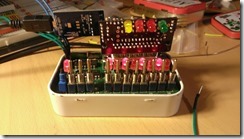 One of the guys on the COSMAC ELF mailing list, Bill Rowe, asked the people on the list if they would be interested in purchasing a run of boards for my serial port adapter. Right after I read that on the mailing list, I saw a message from Bill in my inbox asking me if I’d be interested in working with him to make a printed circuit board for the project and sell it to people who are interested.
One of the guys on the COSMAC ELF mailing list, Bill Rowe, asked the people on the list if they would be interested in purchasing a run of boards for my serial port adapter. Right after I read that on the mailing list, I saw a message from Bill in my inbox asking me if I’d be interested in working with him to make a printed circuit board for the project and sell it to people who are interested.
I was OK with the idea, but with everything that’s going on with Dana I haven’t had a lot of time for other projects. Or at least I didn’t think that I did. I sent the schematic and board files to Bill so that he could make a first pass on them – once he sent them back I started playing with the board files until I had something that I could send off to Osh Park to have fabbed. Waiting the two weeks that it takes to get the boards back isn’t fun, but it beats waiting months – or not making the project at all because you don’t have a board.
Anyway, the boards came back from Osh Park, the parts that I ordered online came in (along with a whole bunch of other stuff that I didn’t really need but I thought, what the heck, I’m ordering) and I started finding all of the little things that I managed to do wrong. The DB-25 connector needs to be on the solder side of the board, not the component side. Somehow I missed where I crossed two traces. After I corrected those two faults (one with a knife and a bit of wire, the other by putting the LEDs on the solder side) it actually worked the first time when I got the prototype built.
I’m pretty proud of the whole thing. Something that I designed and outsourced work on and built myself all works like I intended it to.
I’ve already sent out the Rev. B of the board. It will have the DB-25 connector on the other side, and with that change I was able to add a couple of other jumpers to make it easier to put the LED enable and oscillator enable lines under control of the Picaxe. But the first one will always have a special place, ‘cause it was my first.